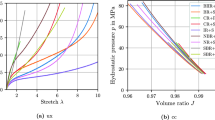The asymmetric theory of elasticity is used to model a hybrid laminated composite of regular structure with all phases isotropic. The effective thermoelastic characteristics of the composite are determined. It is shown that the equations derived can be used to determine stress–strain state in all the phases of the composite using the average components of the tensors of force stresses, couple stresses, strains, and wryness in a layered material, which is of fundamental importance for the design of composites based on structural theories of failure
Similar content being viewed by others
References
S. A. Ambartsumyan, General Theory of Anisotropic Shells [in Russian], Nauka, Moscow (1974).
A. N. Andreev and Yu. V. Nemirovskii, Multilayer Anisotropic Shells and Plates: Bending, Stability, and Vibration [in Russian], Nauka, Novosibirsk (2001).
V. V. Vasil’ev, Mechanics of Composite Structures [in Russian], Mashinostroenie, Moscow (1988).
S. G. Lekhnitskii, Anisotropic Plates [in Russian], GTTI, Moscow (1957).
Yu. V. Nemirovskii and A. P. Yankovskii, “Effective physical and mechanical characteristics of composites unidirectionally reinforced with monotropic fibers. 1. Model of reinforced medium,” Izv. VUZov, Stroit., No. 5, 16–24 (2006).
Yu. V. Nemirovskii and A. P. Yankovskii, “Effective physical and mechanical characteristics of composites unidirectionally reinforced with monotropic fibers. 2. Comparison of calcualted characteristics and experimental data,” Izv. VUZov, Stroit., No. 6, 10–19 (2006).
W. Nowacki, Theory of Elasticity [in Polish], PWN, Warsaw (1970).
V. G. Piskunov and V. E. Verizhenko, Linear and Nonlinear Problems in Design of Layered Structures [in Russian], Budivel’nyk, Kyiv (1986).
A. O. Rasskazov, I. I. Sokolovskaya, and N. A. Shul’ga, Theory and Design of Layered Orthotropic Plates and Shells [in Russian], Vyshcha Shkola, Kyiv (1986).
L. P. Khoroshun, “Relationships between stresses and deformations in lamellar media,” Int. Appl. Mech., 2, No. 2. 9–11 (1966).
L. P. Khoroshun, “Derivation of equations for laminate plates and shells,” Int. Appl. Mech., 14, No. 10, 1021–1034 (1978).
L. P. Khoroshun and E. N. Shikula, “Short-term microdamage of a physically nonlinear laminate under simultaneous normal and tangential loads,” Int. Appl. Mech., 43, No. 4, 409–417 (2007).
L. P. Khoroshun and E. N. Shikula, “Mesomechanics of deformation and short-term damage of linear elastic homogeneous and composite materials,” Int. Appl. Mech., 43, No. 6, 591–620 (2007).
L. P. Khoroshun and D. V. Babich, “Stability of plates and shells made of homogeneous and composite materials subject short-term microdamage,” Int. Appl. Mech., 44, No. 3, 239–267 (2008).
Author information
Authors and Affiliations
Corresponding author
Additional information
Translated from Prikladnaya Mekhanika, Vol. 45, No. 11, pp. 71–79, November 2009.
Rights and permissions
About this article
Cite this article
Nemirovskii, Y.V., Yankovskii, A.P. Determining the effective thermoelastic characteristics of regularly laminated composite in the asymmetric theory of elasticity. Int Appl Mech 45, 1206–1213 (2009). https://doi.org/10.1007/s10778-010-0260-1
Received:
Published:
Issue Date:
DOI: https://doi.org/10.1007/s10778-010-0260-1




